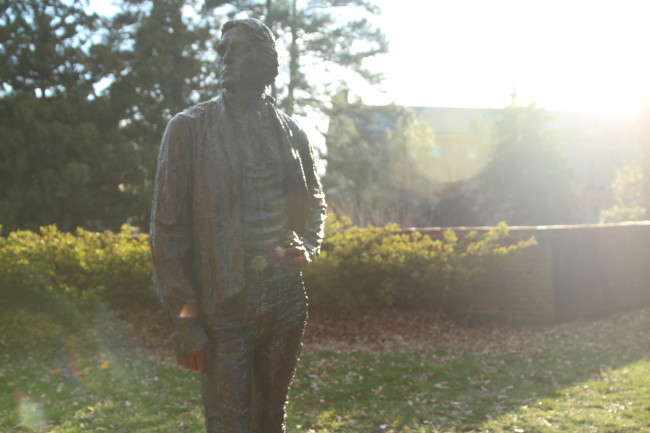On Feb. 11, the College of William and Mary police department reported an instance of vandalism on the Thomas Jefferson statue, and the incident has sparked a series of discussions both on and off the College’s campus.
The vandalism — officially referred to as a “destruction of property” — was officially documented at 11:22 p.m. Both of the statue’s hands were painted red and the statue’s base was spray-painted with the words “slave owner.” The William and Mary Police Department differentiate this from previous instances of targeting the statue, such as covering it in post-it notes that reference Jefferson’s slave-owning history, because they must manually remove the paint. At this time, the WMPD has not identified a suspect.
The first public acknowledgement of the defacement seems to have occurred on the Facebook page, “Overheard at William and Mary,” when Brendan Thomas ’18 posted about it at 12:37 p.m. Feb. 11, 11 hours before the WMPD documented it. His post contained a pair of pictures showcasing the described graffiti with the attached text, “Overseen: Thomas Jefferson with the blood of all the people he owned on his hands.” Thomas said he initially saw the graffiti on the statue while passing by and felt a sense of sympathy with the individual who vandalized the statue.
I think that the interesting things about statues of like Jefferson and Monroe, they’re designed to lionize a historical figure,” Thomas said.
“I think that the interesting things about statues of like Jefferson and Monroe, they’re designed to lionize a historical figure,” Thomas said. “[The graffiti] brings the attention of the person looking at the statue away from this sort of mythical view of him. This guy is not made of stone, he’s a real person who had significant flaws and did some pretty terrible things.”
Thomas’ post sparked a discussion on “Overheard at William and Mary,” with both current students and alumni of the College sharing their thoughts. Many people brought up points regarding white privilege, social protest, historical revisionism and the defacement of property.
Reflecting on the subsequent discussion that began on his post, Thomas said that the graffiti has the potential to help people learn that historical figures might have flaws that are overlooked because of that figure’s significance.
“When we look at historical figures like our founding fathers, who are prone to being mythologized and lionized, we have to take a careful stance to remember not just Thomas Jefferson but also the people he owned,” Thomas said. “We’re told we sort of have to worship them and that whenever any sort of challenge is brought up it has to be immediately shut down and condemned.”
Not all students agree with the vandalism, however. Catie Burgess ’20 said she believes that while Jefferson was not a perfect individual, she thinks that vandalizing a statue of him does not create a meaningful point of discussion.
“I think [the graffiti] shows a lack of patience because a lot of us are really willing to discuss any controversy over the statue,” Burgess said. “I don’t think we should be taking any of these historical figures at face value. If you want to admire Jefferson for his intellectual contributions then that’s great, but you should also acknowledge that he wasn’t the greatest person.”
Burgess also said that without a controlled, constructive environment to hold discussions like these in, the original reason for discussing the point can become lost.
“I don’t entirely know what [the graffitist] is standing for here,” Burgess said. “I’ve heard so many things in opposition to Jefferson, from racism to sexism to him being a slave owner to him being a plutocrat. I guess I would want to talk to them first in person and know what their stance is.”
Alumni formed a large portion of the opposition to the graffiti placed on the statue. Andrew Langer ’93, an alumnus, posted a live video on the ‘Overheard’ page of him bringing a Valentine’s Day card to the statue to show support for the Founding Father.
“It was a flash of inspiration that came to me literally in the space of about five minutes,” Langer said. “I saw the news report, I happened to be home, I happened to have a free couple of hours on Wednesday morning, and decided to drive over to campus. As I was driving, I said ‘Do you know something? Let me swing by the Food Lion and grab a Valentine’s card,’ because you know something? With the statue being vandalized, I thought it was important for an alumnus to stand up and show T.J. a little love.”
Ellie Grace ’19, who said they were a supporter of the graffiti, noticed this and believes it added to the tension and stress of discussing the statue.
The [alumni] played such a huge role in fighting against it and all I’m thinking is that, in the past, the campus was very white when they went to school,” Grace said.
“The [alumni] played such a huge role in fighting against it and all I’m thinking is that, in the past, the campus was very white when they went to school,” Grace said. “There’s a lot of different people on campus now. We have to memorialize everyone’s history, not just white people’s history, and I think that it’s almost a generational divide on the ‘Overheard’ group.”
Six documented cases of vandalism have occurred on campus between Feb. 10 and Feb. 17. The instances included the words “Punch ur local nazi” and “Smash Fascism” on the Millington Hall construction site, “Robert Gates is a war criminal” on Phi Beta Kappa Hall and Andrews Hall, “Genocide happened here” out front of Kaplan Arena.
“As we have previously said, while William & Mary is a place where we encourage civil discourse about challenging topics, it is not acceptable to deface property to express an opinion,” College spokesperson Suzanne Seurattan said in an email.
Despite the tensions that have risen from the discussions on ‘Overheard,’ Grace believes that the conversations have been positive, for the most part. Grace said that they have made an effort to reach out and understand the point of view of the other side to help bring the community together.
“[The graffiti] gets a lot of people angry, but maybe it will just make people think a little bit,” Grace said. “It makes me think about the side I disagree with, and I want to see things from that point of view. I want to see where those people are coming from, to put myself in those people’s shoes to think about what they’re saying.”



































so uh what happened to including Kyle Lopez tho?
Why don’t they replace the statue of Thomas Jefferson with a statue of George Jefferson? Everyone loves him and he ain’t no racist. Damn. *•-:¦:-•:*””*:•-:¦:-
Sharpton☻ / Waters ☻ 2020